How to Create a B2B SEO Strategy: A 5 Steps' Guide

Natalia Toth
61% of B2B marketers believe that SEO generates more leads than any other marketing channel. Yet, only half of B2B companies have a full-fledged SEO strategy.
If you belong to that other half, the time has come to develop a working SEO strategy for your B2B product or service. But how can you ensure that it hits the mark?
In this guide, we’ll walk you through five steps to creating a robust B2B SEO strategy that brings about gains.
How is SEO for B2B different?
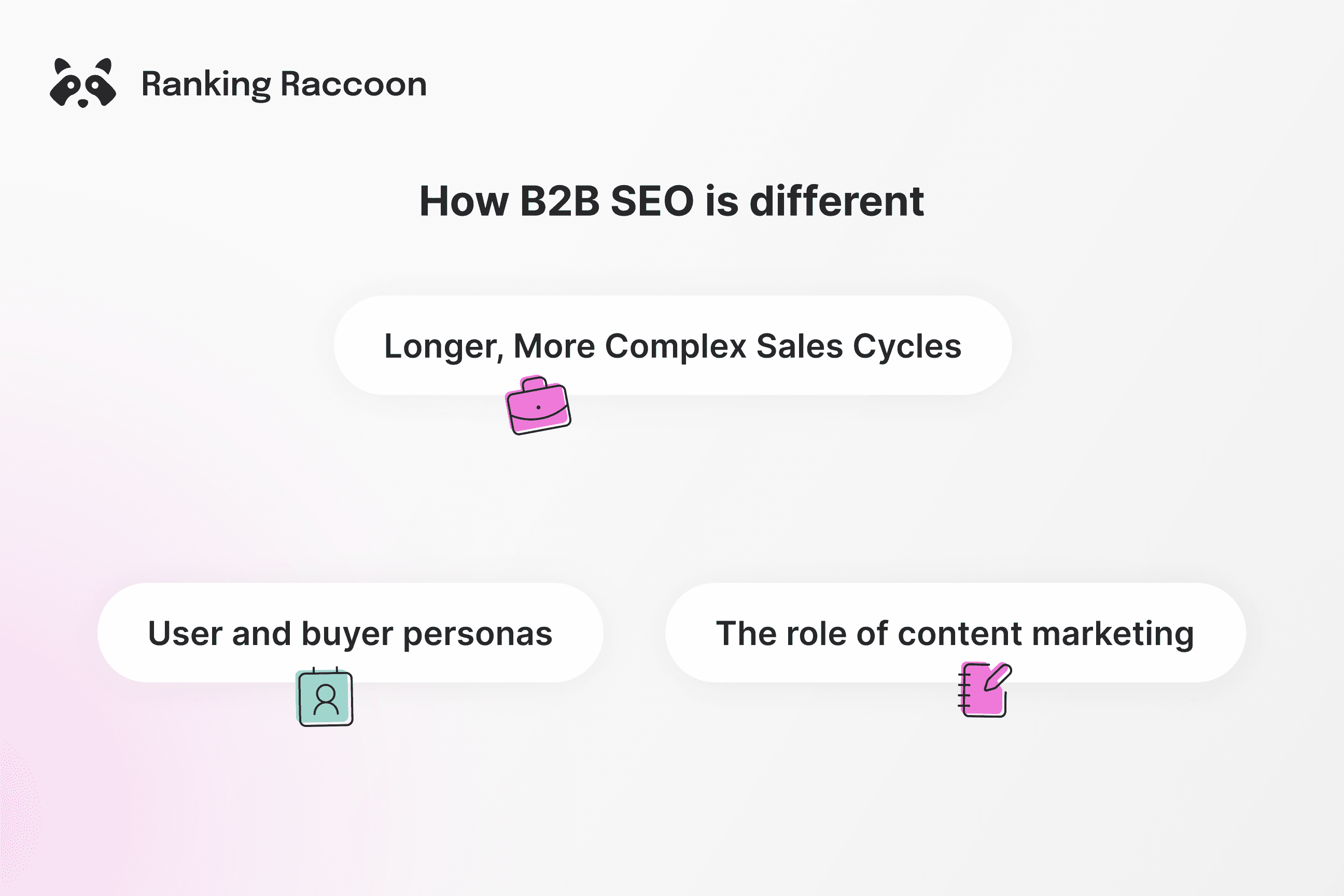
Longer, complex sales cycles
B2B transactions involve a more complex decision-making process and a longer sales cycle. That's especially true in the Enterprise segment, where deal size can reach a few million dollars. It’s not uncommon for B2B clients to take up to 180 days or even a year to make the decision.
To help the sales team move leads towards deal closure, your SEO strategy should address each stage of the long buyer’s journey.
‘In B2B, you need to create content for different levels of the funnel. Of course, your service pages are usually the most important ones. However, publishing a range of content for different stages of the funnel enables you to catch a wider range of people at different stages of readiness to purchase. Use this content to share a good amount of expertise, demonstrating value to potential buyers.’
Account Director, SEOworks
‘One pitfall I see across many B2B companies is failing to align the content with the buyer's journey stages. B2B marketers should address each stage of the sales cycle in their content. This means producing detailed guides, case studies, and whitepapers that help educate and nurture leads over time.’
Marketing & SEO Manager, Mailbutler
User personas and buyer personas
In B2B, you're not targeting one individual but a group of decision-makers with varying roles, goals, and interests. On average, a B2B purchase involves about 11 stakeholders, and sometimes, this figure can rise to 20!
Imagine you sell software for developing an e-commerce website. Your user persona will be a frontend developer. Your buyer personas can be the Chief Product Officer, Head of Engineering, Head of E-commerce, Chief Marketing Officer, and even the CEO. And yes, your content and SEO strategy must cater to the needs and pain points of all these people.
For instance, the Head of Engineering might be wondering ‘Is this solution compatible with our existing tech stack?’. The Head of E-commerce is curious about the potential impact on sales, while the CMO can be thinking “Will this software let our marketers launch promotions fast and easily?’
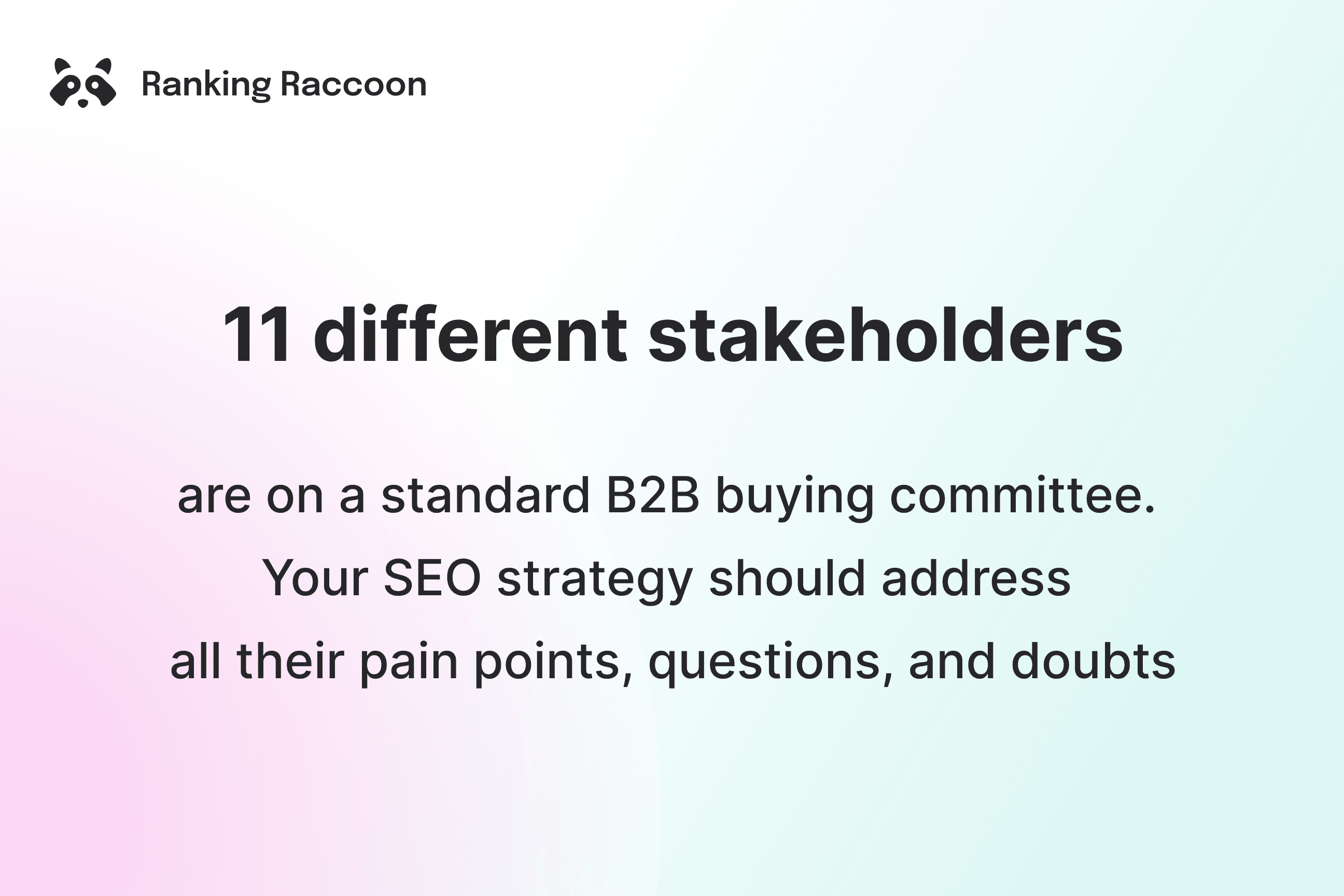
To identify what buyer personas worry about and look for, a sound market and user research is a must.
One of the best approaches to finding customers’ pain points and motivations is the Jobs-to-be-Done framework. You could ask your customers questions like:
- What problem were you trying to solve when you first sought out our product/service?
- Can you describe the moment when you realized you needed a solution like ours?
- What other solutions or methods did you try before choosing our product/service?
- What results were you hoping to achieve with our solution?
- How has using our product/service impacted your daily workflow or business operations?
The role of content marketing
If you’re an SEO or content marketer in B2B, you’re probably underestimating your impact on the company’s bottom line.
Here’s why your role is more crucial than you think:
- Potential buyers review three to seven pieces of content before reaching out to your sales team
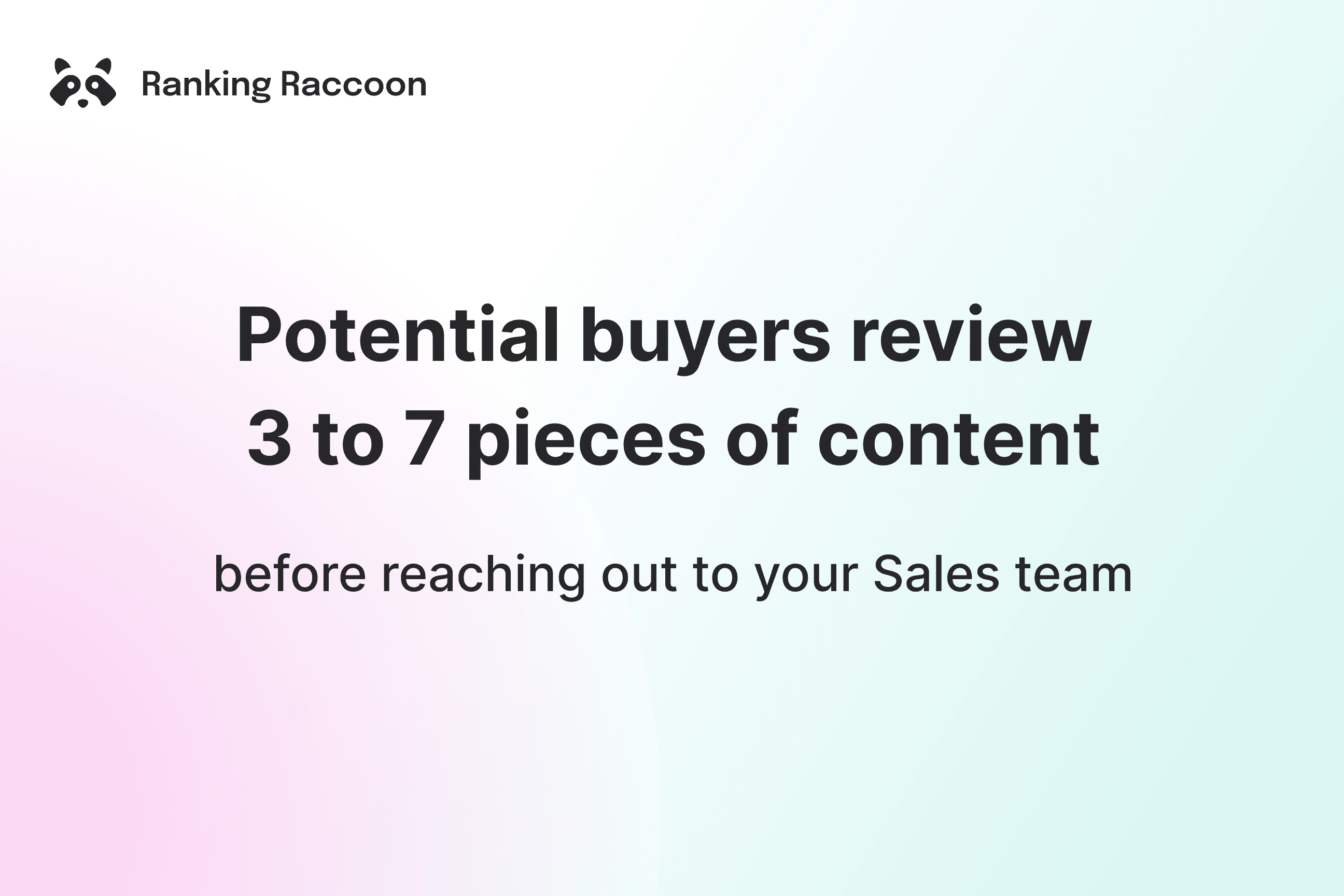
- 33% of B2B buyers prefer a sales experience without direct seller interaction
- This is especially true among younger decision-makers: 44% of millennials prefer to avoid talking to sales altogether
- 60% of B2B companies acknowledge that SEO plays a critical role in lead generation efforts
- Two-thirds of B2B marketers consider blogs the most valuable marketing channel. Consistent blogging generates +67% leads per month
- SEO can lower your Customer Acquisition Cost (CAC) by as much as 90%
Let’s talk a bit about the last point. CAC is calculated by dividing the total expenses on sales and marketing by the number of customers acquired over time. According to Userpilot, the average CAC for B2B companies is $536, and in niches like Fintech, Software Development, or Legal, it can exceed $700 per customer. Not every penny spent on sales and marketing results in a new active customer. Such expense is irreparable and affects your profitability.
When done right, SEO can bring your CAC down by up to 90% by guiding site visitors towards taking the next step without direct sales or business development team’s involvement.
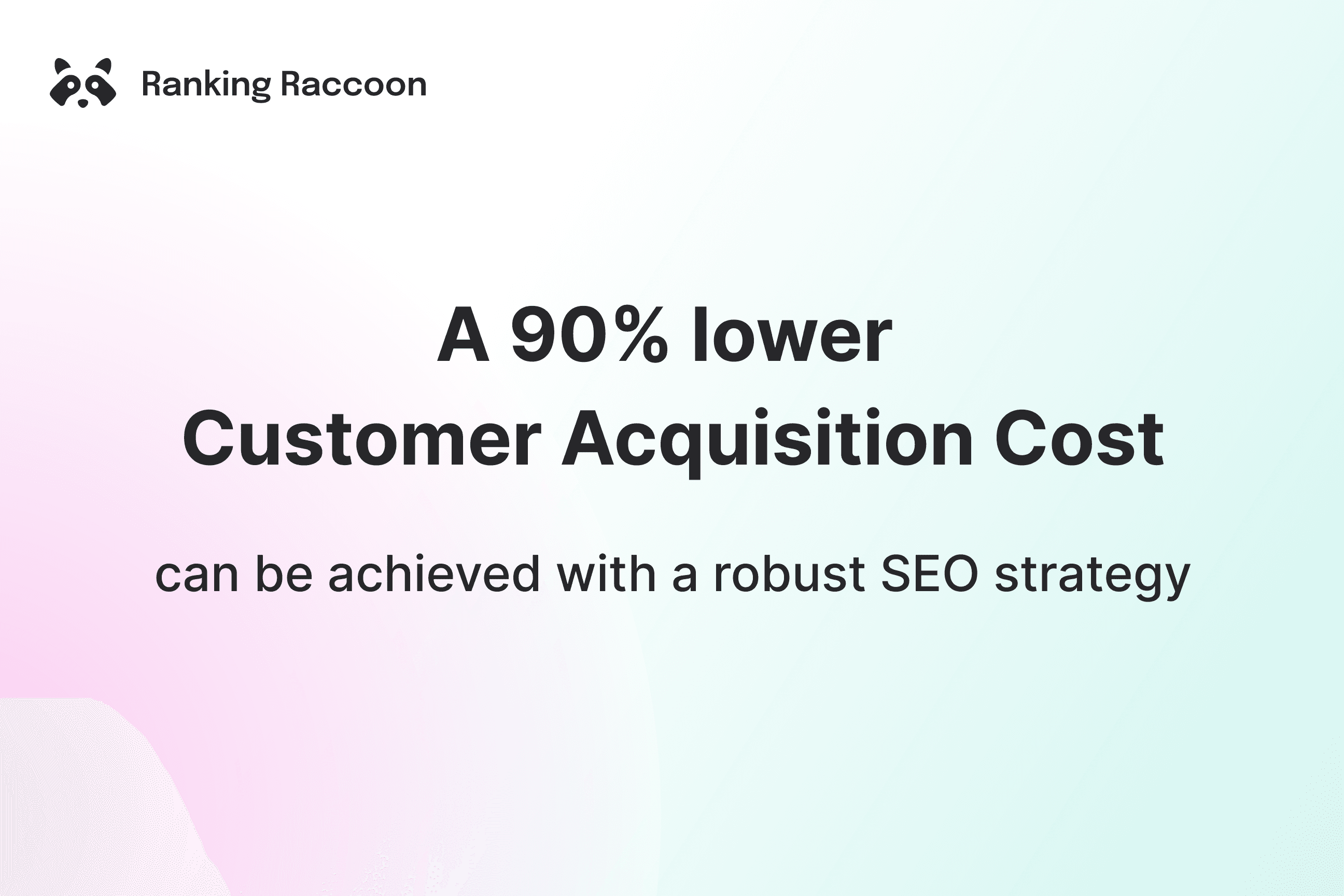
How do you develop a B2B SEO Strategy? The 5 steps
Step 1: Conduct Thorough Keyword Research
Prioritize high-value, long-tail keywords
Identify and target keywords relevant to your industry, products, and services. Use tools like SEMrush, Ahrefs, or Ubersuggest to find keywords with high search volume (SV) and low competition, or keyword difficulty (KD).
Focus on long-tail keywords, as they attract the leads with the highest search intent. According to Smartinsights, long-tail keywords generate a 3-6% better CTR.
Let’s see how this could work in practice.
- If you’re in the Logistics and Supply Chain industry, target long-tail keywords like “how to choose a supply chain management solutions” and “top supply chain management solutions for e-commerce.”
- In the Human resources field, focus on keywords like “HR software solutions” and long-tail variations such as “best HR software for mid-sized businesses.”
- In the IT services industry, pinpoint long-tail keywords like “affordable IT support for small businesses.” Incorporate industry-specific terms like “managed IT services,” “network security,” and “cloud infrastructure management” to enhance relevance and authority
- For Legal, the relevant keywords could be “corporate legal services” and long-tail phrases like “best corporate legal services for startups.”
Incorporate industry-specific terms
Given the specialized nature of B2B markets, you must address the industry-specific terms. Why? Because they not only help attract the right audience but also establish your expertise in the field.
However, be cautious not to overkill with extremely rare, specific, or newly invented terms.
“It would be a mistake to focus too much on industry jargon. This can alienate potential customers who are not as familiar with those terms.”
Ilija Sekulov
Marketing & SEO Manager, Mailbutler
- If you sell B2B marketing software, terms such as “lead nurturing” and “ABM (Account-Based Marketing)” connect with potential clients and demonstrate your industry knowledge.
- Terms like “portfolio management” and “risk assessment” can help build up credibility and attract businesses seeking specialized financial advice in financial services.
- In the Legal niche, industry-specific terms like “corporate compliance,” “contract negotiation,” and “legal risk management” demonstrate expertise and attract an audience that is motivated to buy.
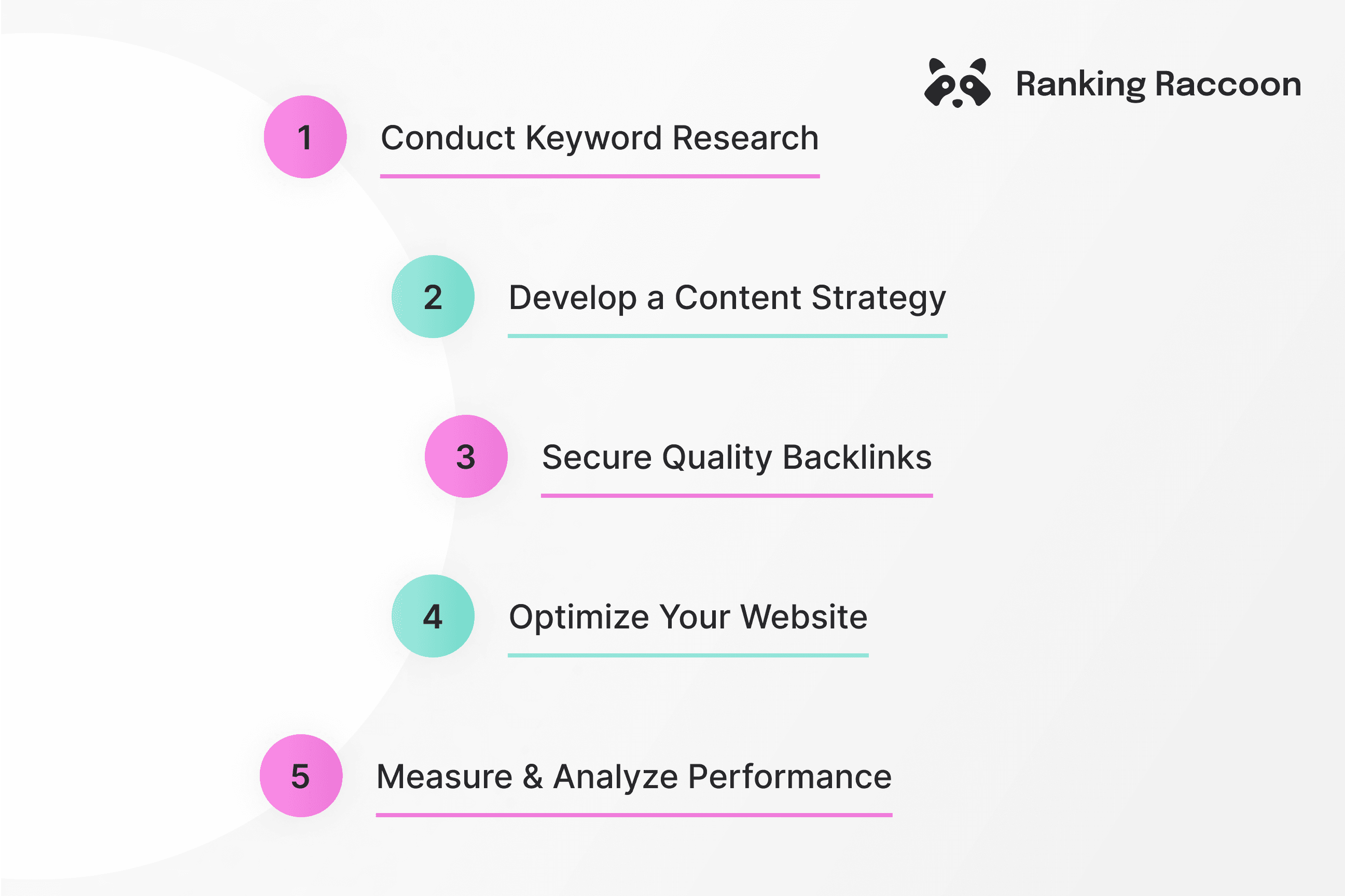
Step 2: Develop a content strategy
Now that you have decided which keywords you’ll be targeting, it’s time to devise a content strategy based on them - and based on what your audience looks for.
Align content with SEO Goals
Your content strategy should align with your SEO goals and accompany the potential buyer at every stage of their decision-making process.
Which types of content work best?
- For the Awareness stage, also known as middle-of-the-funnel, you can employ blog posts with original content (for instance, a ‘State of [Your Industry] Report’). They’re great for attracting new visitors and addressing their initial questions, as well as making them remember your brand as a thought leader in the niche. In fact, HubSpot found that businesses that blog regularly generate 126% more leads than those that don't.
- For the Consideration, or middle-of-the-funnel, stage, create whitepapers, e-books, webinars, and product videos. They’re ideal for in-depth exploration of topics, showcasing your expertise, and generating leads.
- For the Decision phase, the so-called bottom-of-the-funnel, case studies and customer success stories are your best friends. They help assuage buyer personas’ concerns, set expectations, and convince potential clients to decide in your favor.
As Forbes reports, 53% of B2B marketers believe that case studies, customer stories, and videos are the best content formats for generating engagement, because they showcase practical examples.
Thought leadership and educational content position your brand as an industry leader and can significantly boost your SEO efforts. 51% of B2B marketers value thought leadership pieces for their depth and insight, while 47% prefer shorter blog posts for their clarity.
Step 3: Secure quality backlinks
If the content is king, a good link-building strategy is the queen that supports him and makes him rule better.
Link-building belongs to the off-page SEO realm, and many marketers refer to it as the most challenging part of their SEO responsibilities. But worry not - we have some piece of advice for you!
Build backlinks from sites in your industry
You’ll encounter thousands of shady link offers in your inbox and social media accounts, but here’s our tip: focus on acquiring high-quality backlinks from reputable sources in your niche. These are most likely to generate clicks and drive traffic to your site. And as Google’s Leaked docs recently confirmed, only backlinks that actually generate user clicks matter for your search visibility.
There are plenty of awesome link-building tools that make this daunting SEO task more enjoyable.
For example, on Ranking Raccoon, you can browse verified websites in your industry and send a link request to the real site admin directly in just a few clicks. This way, you don’t have to waste your precious time on prospecting and cold outreach - and have confidence that the backlinks are genuine and efficient.
Leverage industry relations
Your existing business partnerships (e.g. technology alliances, solution integrators, distributors, and resellers) are probably the lowest-hanging fruit for link-building.
Exchange backlinks in co-marketing campaigns such as joint webinars or co-written reports, and engage with industry influencers to amplify your content.
‘I think we'll see more companies collaborating on content, sharing their expertise openly. Sharing insights generously always looks good from a brand perspective, and we are starting to see that that has knock-on benefits for SEO, too.
So, going forward, I think we should see SEOs doing less stuff "for Google," and more relationship-based activities that are intimately integrated with wider marketing efforts.'
Michael Sandford
Account Director, SEOworks
Read more: Link-Building for SaaS: The Ultimate Guide for 2025
Step 4: Optimize your website
Customer-oriented, SEO-optimized content is king and a robust backlink profile is queen, no doubt about that.
But there are other factors you should take into account, such as on-page SEO optimization. Nearly 4 in 10 marketers say that on-page optimization is the fastest way to achieve SEO success.
Let’s see what four on-page aspects can bring you tangible results in a short time.
- Meta Titles and Headers
According to Moz, optimized meta titles boost CTR by up to 20%.
Why? If your meta titles, descriptions, and headers include your target keywords, it helps search engines figure out what your site pages are about.
- Structured Data and Schema Markup
Schema markup is a structured data vocabulary that helps search engines get a better grasp on your content, enhance search results (even featuring your content in rich snippets), and drive more visitors.
Search Engine Land found that sites with structured data see a 30% increase in click-through rates, and Milestone Inc. reported a 20% boost in organic traffic for sites using schema markup.
- Mobile-Friendliness
Nowadays, tons of users are browsing on their phones - and your B2B buyers are no exception. Google says that 61% of users won’t return to a mobile site with poor UX, and 40% will jump to a competitor.
So it’s worth making sure that your site looks and works great on all devices with responsive design.
- Site Speed
Faster sites deliver a more seamless UX which motivates potential customers to take action.
A 1-second delay can drop conversions by 7%, and 53% of mobile users ditch a site that takes over 3 seconds to load. Last but not least, site speed is one of the key ranking factors for Google’s algorithm.
You can get an overview of any URL’s performance for free in Google’s PageSpeed Insights. It will show you how quick, accessible, and overall performing your site is. Some ways to speed up your site are compressing images, using browser caching, and minimizing JavaScript.
Step 5: Measure and analyze SEO performance
Congratulations, you’ve done it! You’ve done solid research and come up with a robust B2B SEO plan for your site.
Any plan needs adjustments at times, so you must review the results regularly.
Tools like Google Analytics, Google Search Console, and SEMrush all offer vast analytics capabilities. Use them to track your SEO performance, identify trends, and make data-driven decisions.
Here are the five most important SEO metrics for the B2B space:
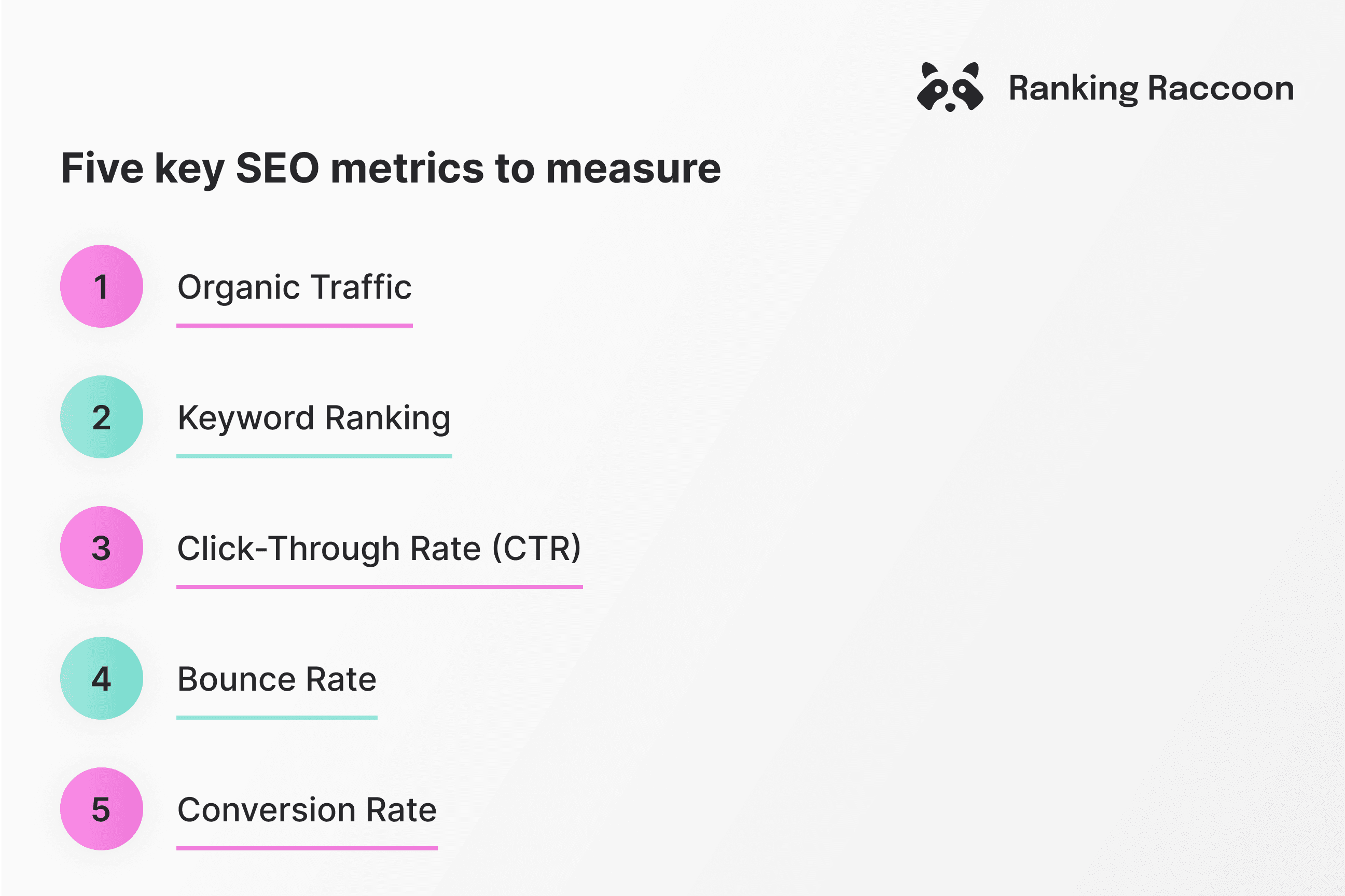
- Organic Traffic
Indicates SEO effectiveness in attracting potential customers to your site. You can see it in Google Analytics: go to Reports -> Generate leads -> User Acquisition and Traffic Acquisition -> Check out the numbers for the ‘Organic Search’ channel group.
- Keyword Ranking
Shows what position your site reaches in search results for a specific targeted search query You can track the keyword ranking in SEMrush, Ahrefs, or a similar SEO optimization tool.
Read more: 12 Best SEO Software Tools for Your Small Business [A 2025 Review]
- Click-Through Rate (CTR)
Shows how compelling meta tags and descriptions for your content are on search engines. You will see the CTR in the Search Results tab in your Google Search Console account.
- Bounce Rate
Bounce rate refers to the number of page visitors who leave it without taking any action.
Generally, if we speak about a page where you want site visitors to perform an event (e.g. sign up for the free trial or contact sales), the lower the bounce rate, the higher the user engagement and your chances to generate leads. According to Contentsquare, the average bounce rate for B2B sites stands at 61%. It's normally higher for blog posts as visitors come there only to get information.
You can find the bounce rate in Google Analytics 4. First, choose a report, and then on the right side, hit ‘Customize Report’ -> Metrics -> Add Metric -> Add the Bounce rate.
- Conversion Rate
Tracks the percentage of site visitors who take a desired action (such as hitting the ‘Request demo’ button). You’ll find it in your Google Analytics account - you just need to set up the relevant events in the Events tab and select the key ones.
A common mistake to avoid
A trap many B2B companies fall into when designing their SEO plan is focusing too much on what competitors are doing without a thorough analysis. At times, alternative strategies may help you stand out more efficiently.
‘A common issue is not understanding where competitors are in relation to you. For example, you might see that your competitor has a strong brand, and lots of traffic from branded searches. But this doesn't tell you whether their customers are converting. By helping these customers with your content, you could win them over.
Similarly, a competitor may rank well for a desirable target keyword. But how much is that keyword converting? By targeting other longer-tail keywords, you could win just as many new customers.
It's important to be aware of competitors, but it's also important not to get hung up on where they seem to be outdoing you. Maybe you don't need to beat them at their own game, but can beat them by being creative in closely related areas.’
Michael Sandford
Account Director, SEOworks
Conclusion
Well done on making it this far! SEO plays a big role in any solid digital marketing strategy. Nailing a B2B SEO strategy means getting a good grip on what your industry and audience need.
By knowing the ins and outs of B2B SEO and following the five steps above, you'll see a big improvement in your online visibility. Keep in mind that SEO isn't a one-time thing—it's an ongoing process that needs regular check-ins and updates to stay ahead of the game.
Put in the effort to fine-tune your SEO, and watch your B2B business take off. We’re rooting for you!

Natalia Toth
Marketing Manager